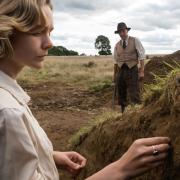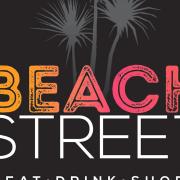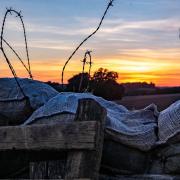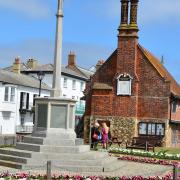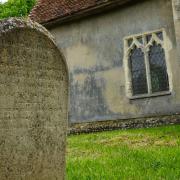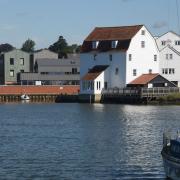Carol Twinch recounts the fascinating history of Lowestoft's seaside past
You can’t beat a day out at the British seaside... or can you? Four of our writers remember childhood summers spent at different Suffolk resorts, starting with Carol Twinch’s look at the history of Lowestoft’s Beach Village
It is a well known fact that Ness Point, Lowestoft is not only the most easterly point of Suffolk but also of the British Isles. It is marked by a compass and Euroscope (a circular platform showing the direction and distances of major European towns and Great Britain’s other cardinal points) which are found beside Suffolk’s first and largest commercial wind turbine. But a short way up the coast once stood the old Beach Village that began on the Denes in the 1760s and was, for around 250 years, the most easterly community in Britain. A few large, rusty anchors on the pebbled foreshore north of Whapload Road, together with the remnants of some net drying racks, are all that remains of the Beach Companies and their village. But these and Lowestoft’s famous ‘scores’ (the winding paths down the cliffs) are enduring memorials to both the fishing trade and all aspects of seamanship which have gone to make the town what it is today.I was at school in Lowestoft when the remains of the Beach Village were swept away, in the name of ‘slum clearance’ in the 1960s, but it was many years later that the whole story came to be written. Local history is like that: things have to be put in some perspective before they can be studied and evaluated. The men of the Beach Companies operated along the shore between 1762 and 1940 when their main business was recovering (or ‘swiping’) anchors and cables which had been lost from ships riding out gales in the offshore anchorages. In the late 18th and early 19th century, vessels gathered in very large numbers at Ness Point, waiting for a change in wind direction. Some of them would have lost their anchors and relied on being able to buy a replacement from the range of salvaged anchors offered by the Beach Companies. In addition to salvage the main work was pilotage and, when the need arose, lifesaving from ships driven on to the treacherous offshore sandbanks. The Beach Company boats, known as yawls (or yoles), were fast, open beach boats about 50 feet in length.The local fishermen used longshore boats (along the shore) and, later, sailing smacks and then steam drifters. By the early 20th century the longshore boats had become trawlers and the fishing industry the mainstay of the local economy.Needless to say, both the fishing and Beach Companies men owned a high degree of skill and had all known the offshore waters as man and boy. Indeed, so renowned was their seamanship that in the 18th century the notorious press gangs were busy in the town, seizing men to serve in the Navy.Gradually the sheds and shacks of the 1760s became more numerous and more permanent so that by 1791 the first primitive houses were built on a small tract of land lying below the cliffs. Known as the ‘fish houses,’ they consisted of little more than four rooms (two-up, two-down), which accommodated an entire family some with as many as 12 or 13 children. The historian Edmund Gillingwater recorded that 76 brick and flint tenements were built between 1791 and 1806 ‘and this was the beginning of Lowestoft’s famous Beach Village, or “the town below the cliff” as it became known’. The village was predictably ramshackle and its people poor in the extreme, living mainly on herring. Being so close to the sea had obvious hazards and in 1897 the whole village was flooded during a storm. The men who had put to sea to assist vessels in distress returned to find their homes under several feet of water. Yet in 1900 the Beach Village had a population of 2,500, 13 public houses and several ranges of working buildings.In order for the villagers to reach the town, perched on top of the cliff, they used the ancient thoroughfares known as ‘scores’. Opinions vary as to the precise origin of the word ‘score’ but the general consensus is that it comes from the verb ‘to scour’ which in turn derives from the Old Norse ‘skor’ which means to notch or slash a line. The paths run naturally down the cliff face or, as given in The Suffolk Dialect, each one is ‘a cutting down a declivity’. Nowadays visitors and locals alike delight in discovering the remaining scores on the Lowestoft Scores Trail, all of them named and each with its own potted history.There is even a Lowestoft Scores Race organised by the Waveney Valley Athletics Club each September. It is Britain’s most easterly hill race and was resurrected in 1996, the first since the 1930s. The arduous 4.75 mile race begins in the High Street and goes along Links Road followed by 13 scores (409 steps) and finishes at the historic Triangle Market.By the 1950s the Beach Village was almost derelict, its inhabitants having moved up into the town. When the area was cleared in the early 1960s a few net drying racks were left behind. These had been used by the families to dry drift nets before storage at the end of the fishing season. If put away damp they would rot. In the days of steam drifters, each vessel carried almost two miles of net and as there were nearly 800 drifters fishing from Lowestoft in the 1890s, row upon row of racks were needed. At the turn of the 20th century there were more drifters registered at Lowestoft than at any other English port.Once landed, the fish were gutted and barrelled in brine out in the open to the south of where the racks stood. Each year over a thousand Scottish fisher girls came here for the Great Autumn Fishery, the industry reaching a peak in 1913 when 535 million herring were landed at Lowestoft.The story of the Beach Village, the scores and the fishing families can usually be found at the Maritime Museum on Whapload Road but at time of writing it is closed. However, the Lowestoft Museum in Oulton Broad is open daily and delights in having just been given accredited status by the Museums Libraries Archives Council. They have displays of geology, fossils and Stone Age settlements through the archaeology of Roman and Anglo Saxon sites to the present day. There is even an old, and very heavy, lifebelt taken from the Beach Village and a photograph of the Frances Ann lifeboat, which was one of the first ever lifeboats based on the yawls of the Beach Companies.Having forgotten my glasses a kind lady volunteer named Kathy lent me hers, which was fine until she showed me the museum’s wonderful collection of 18th century Lowestoft porcelain, the third most comprehensive display in England. One of the designs was intriguingly described as ‘two dromedaries on a bridge’ and I asked her to point it out to me. “Well,” said Kathy, narrowing her eyes, “you’ve got the glasses!”



